It’s Madison Time!Another Columbus First?by Doug Tracy
Columbus lays claim to a number of ‘firsts’ that include the first Junior High School (Indianola Junior High in 1909), the first kindergarten (1838 by German settlers), the first shopping center, the first filling station (Standard Oil of Ohio at Young and Oak streets in 1912), the first banana split (Foeller’s Drug Store on North High Street), the first Miss America (Mary Catherine Campbell, 1922), the first Wendy’s restaurant and the first gorilla born in captivity (Colo in 1956).
Now you can add another one to your list of Columbus trivia: The Madison Dance, purportedly invented by William “Bubbles” Holloway and the dancers at the LVA Club on Mt. Vernon Avenue in 1957.
The Dance
So what is the Madison dance anyway? If you were a teenager in the late 50’s or early 60’s, you know that the Madison is a line dance that was the biggest dance craz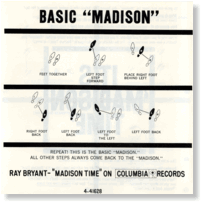 e of the era, not just in the USA, but around the world. If you saw the John Waters 1988 movie Hairspray or have seen the current television series American Dreams, you have seen the kids on the dance floor in a long line, much like the Soul Train line of the 70’s, doing the Madison. e of the era, not just in the USA, but around the world. If you saw the John Waters 1988 movie Hairspray or have seen the current television series American Dreams, you have seen the kids on the dance floor in a long line, much like the Soul Train line of the 70’s, doing the Madison.
The Madison is a basic back-and-forth shuffle done in a line, with a variety of ‘call outs’ for various steps, such as the Double Cross, the Cleveland Box, The Basketball (with Wilt Chamberlain), the Big “M”, The “T” Time, The Jackie Gleason and The Birdland.
The craze spawned Madison dance teams across the nation and intense competitions from city to city, much like the Twist in the 50’s and 60’s, Disco in the 70’s, Break-dancing in the 80’s and the Electric Slide in the 90’s. To this day, the Madison is still taught at many dance studios and it’s not unusual to see it performed at reunions, weddings and parties.
The Music
The Madison also spawned intense competition within the record industry to capitalize on the lucrative market. Many versions of the Madison were frantically recorded and released. Two versions hit nationally, the Ray Bryant Trio’s Madison Time – Part 1 b/w The Madison Time – Part 2 (Columbia 41628) and Al Brown and His Tunetoppers’ The Madison b/w Mo’ Madison” (Amy 804). Even Bill Doggett had a version, The Madison b/w Ocean Liner (King 5204), although Doggett’s version saw only modest chart a and released. Two versions hit nationally, the Ray Bryant Trio’s Madison Time – Part 1 b/w The Madison Time – Part 2 (Columbia 41628) and Al Brown and His Tunetoppers’ The Madison b/w Mo’ Madison” (Amy 804). Even Bill Doggett had a version, The Madison b/w Ocean Liner (King 5204), although Doggett’s version saw only modest chart a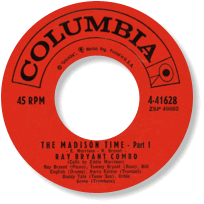 ction. ction.
Al Brown’s release on 4/4/1960 took off first, quickly skyrocketing up the charts to eventually peak at #23 on Billboard and #5 on the Cashbox R&B charts. However, Ray Bryant’s version was rush-released one week later on 4/11/1960 and climbed to #3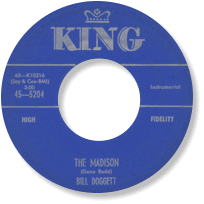 0 on Billboard. 0 on Billboard.
Both records were strong sellers, but the presence of two versions of the Madison simultaneously on the charts meant that neither would enjoy the number one chart position that undoubtedly would have otherwise occurred for one of them. These two records would prove to be the only top 40 hits for both artists, despite long careers and many other recordings in the jazz arena.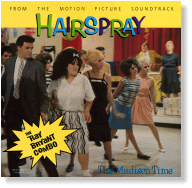
Ray Bryant’s version saw new life in 1988 as a key part of the soundtrack for the movie Hairspray, starring Ricki Lake, Sonny Bono, Jerry Stiller and Divine. In additio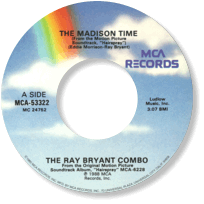 n to inclusion on the soundtrack CD, Ray Brant’s The Madison Time was also released as a single 45 (MCA-53322) that included a picture sleeve showing Ricki Lake and the cast doing the Madison. n to inclusion on the soundtrack CD, Ray Brant’s The Madison Time was also released as a single 45 (MCA-53322) that included a picture sleeve showing Ricki Lake and the cast doing the Madison.
In 2002 the Madison appeared yet again in the currently running Broadway production of Hairspray, starring Harvey Fierstein.
The Artists
Al Brown was a local Baltimore musician who had formed a jazz group known as the Tunetoppers in the late 50’s. The Madison dance was already alive and thriving when Al Brown became aware of it and saw an opportunity to record a song to fit the dance. The recording on the Amy label immediately took off and was a surprise national hit.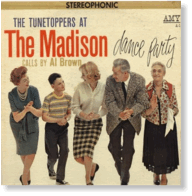
Ray Bryant was a major jazz pianist who was the house pianist at Blue Note in the early 50’s where he backed many notable jazz greats including Miles Davis and Charlie Parker. He later formed a trio and had some minor commercial success with “Cubano Chant’ and “Little Susie”. He also issued a stream of well-received LP’s, but nothing that matched the chart success of “The Madison Time”.
When The Madison Time was recorded, Ray Bryant’s combo included Columbus’s own Harry “Sweets” Edison, a highly regarded jazz trumpeter and a graduate of Columbus East High School. The record also included ‘calls’ by Eddie Morrison, who ironically was at one time a DJ in Al Brown’s hometown of Baltimore.
The Madison in Columbus
According to William “Bubbles” Holloway, Columbus can rightfully lay claim to being the birthplace of the Madison dance, which started right here in 1957 at the LVA Club located next to the Cameo Theatere on Mt. Vernon Avenue. Holloway’s story was chronicled in an article by Lucius E. Lee in the June 18, 1960 edition of the Ohio Sentinel newspaper.
It’s admittedly an obscure bit of Columbus history - maybe not quite as important as the birth of the banana split - but it’s an interesting story nonetheless and, who knows, maybe you can someday win a bar bet with this little piece of Columbus trivia.
_______________________________________________________________________
The Ohio Sentinel
Madison Dance Started In ColumbusBy Lucius E. LeeJune 18, 1960From The Ohio Sentinel
Although it has not become a national issue there are certain rumblings of it in Columbus already with club factions vieing [sic] for t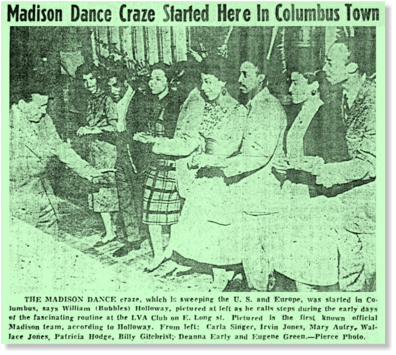 he honor of either starting the Madison dance craze or bringing it to the city. The dance has become international to the extent that it got front page notice in a London daily and column space in one of the tops in American journalism, Time magazine. he honor of either starting the Madison dance craze or bringing it to the city. The dance has become international to the extent that it got front page notice in a London daily and column space in one of the tops in American journalism, Time magazine.
Besides that, it is the most popular dance in the nation and a record, describing its steps by Henry Glover, backed up by Bill Doggett, is at the top of the hit parade. But the dance was first done in Columbus back in 1957 and ’58.
In all probability, the Madison had its start at the LVA Club in Columbus sometime in late 1957. The incidents fall in line like this.
William (Bubbles) Holloway, LVA mentor, was with Sonny Payne and Larry Steele in front of the Birdland in N. York. Bubbles asked Larry how to get to Madison Avenue from the Birdland and he answered: “Take it to the left, young man, take it to the left.”
That remark laid the groundwork for the Madison dance which starts on the left foot, the only dance that does so, and Madison Avenue’s direction from Birdland down Broadway is to the left.
When Bubbles returned to Columbus the Birdland was the craze but that phrase, “take it to the left,” stuck with him. He got Wallace Jones, Eugene Green, Deanna Ely and Carla Singer together with other members of the LVA and, borrowing a step or two from the Birdland, put out a new dance and dubbed it “The Madison.”
Up at the now defunct Downbeat Club, a Nancy Thompson had notions about the same dance but figured it to be a jitterbug version of the Birdland. She trained members of the Downbeat and popularity of the dance spread throughout other clubs.
Its popularity swept the city so the members of Arthur Murray Dance Studio visited the LVA to learn how it was done. The same group visited the downbeat and taught the Cha Cha in exchange for lessons in the Madison.
A group of mail clerks continued to work on the dance at the LVA and organized a team. One member became so enthused that he declared that if the new child in his family turned out to be a boy, he would name him Madison. There is a crumb-crusher with a given name of Madison in the Wallace Jones family now, just about a year and a half old.
According to the incidents, Bubbles is unquestionably creator of the Madison and that makes it a Columbus dance. Be that as it may, there is no doubt he did most to popularize the dance.
He and his team journeyed to Atlantic City shortly after and showed the audience and cast of that fabulous production of Larry Steele, “Smart Affairs,” at Club Harlem how to do the dance. They first danced it for the cast and, just that quick, everyone in the audience was doing the Madison.
Around mid-August of 1959 the team took on a professional role and showed three days at Bubbs Grill in Cleveland. The Madison took on international flavor when Count Basie visited the LVA in Columbus last year and adopted the dance as a feature of his entertainment when he played London and the continent. That is how it got London press notices.
There have been many notions about its origin, some saying that it came here from Indiana, others saying from Detroit, but the only version that makes sense is that it had its real origin in Columbus at the LVA. How else did it come to be called the Madison?
The dance reached its peak of popularity with Columbus folks about a year ago this spring. Madison contests sprang up in all the clubs but the outstanding contest was promoted by the Merry Makers club at Valley Dale which drew the largest crowd ever assembled at the Dale. The contest was won by the 502 Club team. The LVA team, which had really set the basic form for the dance, came in second.
|